A Sustainable Production Model for Potato at Low Latitude Plateau in Winter in Yunnan Province
Jin PU, Elie NTIRENGANYA, Baoju ZHANG, Zhenhua ZHANG, Shen XIONG, Li ZHANG, Hongji ZHANG*, Decai YU*
1.Plant Protection College, Yunnan Agricultural University, Kunming 650201, China; 2.Key Laboratory of Agrobiodiversity and Pest Control,of Yunnan Province, Kunming 650201, China; 3.State Key Laboratory of Conservation and Utilization of Biological Resources of Yunnan Province, Kunming 650201, China
Abstract [Objectives]To find a sustainable production model for potato at low latitude plateau in winter in Yunnan Province.[Methods]Xuanshu 2 potato variety was tested in prefectures of Yunnan Province.Soil covering experiment was conducted in two trials(open field experiment and green house potted experiment).Impacts of three cultivation factors were analyzed:(i)three cultivation models(T1, T2 and T3),(ii)planting density(T1, T2 and T3),(iii)soil covering(T1, T2, T3, T4)on plant growth, and yield production.[Results]The soil moisture content, temperature, roots growth, stems development, leaf area index, and number-weight of tubers per plant and per plot(g)have significantly increased with commercial yield average of 45 t/ha.[Conclusions]The combination of this method with modern agriculture mechanization should be further popularized and applied in large scale planting in regions with climatic conditions similar winter season in Yunnan Province, so as to make contribution to the satisfaction of the world population potato consumption.
Key words Potato cropping systems, Cultivation model, Planting density, Soil cover, Sustainable productivity
1 Introduction
Potato(SolanumtuberosumL.)is the worldlargest non-cereal crop and the fourth largest crop food in China and occupies a critical position for global food security.Due to its location and weather conditions, Yunnan Province is thefourth largest potato producer in China with two-crop a year system.Due to the world population exponential growth about 8 billion of today, to the life standards improvement conditions which led to the increase of migrant to urban zones, there is a growing concern associated with ecological alteration and climate change.This extreme population growth and migration have led to enormous pressure on food production system in the 21stcentury to satisfy the growing population with a smaller rural labor[1].This led to all actors to invest in sustainable crop intensification to improve the production system of particular crops.Potato is the third most important food crop in the world after rice and wheat in terms of human consumption.More than a billion people worldwide depend on potato with global annual total crop production exceeds 300 million t[2]at the average of consumption per capita 32.3 kg in 2018 according to Faostat.Since the 1960s, potato production area has exponentially increased over all other food crops in developing countries.It is an initial element in the food system for millions of people across Asia, South America, and Africa[3].
Since 1993, China has been the world top potato producing country at the total production area of potato 4.9 million ha in 2017, which was the sixth crop after maize(42.4 million ha), rice(30.7 million ha), wheat(24.5 million ha), soybean and rapeseed(NBSC,http://www.stats.gov.cn/tjsj/).China’s top priority in national economic and social development strategy is sustainable agriculture to feed about 1.4 billion of people in its mainland.With the effort of Chinese government in strengthening the food production system, the potato production has doubled in recent 10 years and with expectation of progressive increase.Efforts have been made in researches and sustainable crop extension approach in partnership with international governmental and research institutions[6]to improve both potato quality and quantity.China’s updated annual potato production data showed that about 100 million t representing 33.4% of the world total production at yield average of 17.045 kg/ha[7].Yunnan Province is located in southwest of China, potato production and cultivated area ranked fourth in the country and took up 10.12% of China’s total potato planting area after Sichuan(14.16%), Guizhou(12.64%), Gansu(12.25%)[4].Yunnan Province covers an area of 383 390 km2of which 84% is hills and mountains, 10% undulating, 6% plain and valley[5],which is a restraint to potato production system.However, due to the geographical location, the average annual rainfall is in the range of 500-2 900 mm, altitude of 600-1 600 m, with winter average temperature of 10-21 ℃ and a combination of drought and medium rain, sufficient sunlight, heat, and big difference of day and night temperature provide a better natural environment for potato growth twice a year[8].Potato yield is expected to exponentially increase as potato seed quality improves, cultivation technologies advancement, adoption of new cultivars, and extension of potato farming land due to increase of consumers.In mountainous areas, like Yunnan, ridges and furrows at sloping fields are both important in rainwater collection and potato yield increase with consideration of soil-water conservation in farming fields.The current common methods of potato planting in plateau landscape are both flat field cultivation and single ridge-single row methods with yield range from 12.0-22.5 t/ha[9-10].In this study, we analyzed the effects of cultivation model, planting density, and soil cover on soil moisture content, temperature, crop growth, and yields over a period of 10 years in Yunnan Province.To identify a high-efficiency potato cultivation model, we compared different parameters; the best performance method could be identified and suggested in potato extension and production system in different parts of the world with similar conditions to Yunnan Province.
2 Materials and methods
2.1 Basic experimental designXuanshu 2 potato variety, provided by Yunnan Agricultural University was used in this study.Seeds were collected from Qujing Prefecture, Xuanwei Academy of Agricultural Sciences.For potato planting, we selected slightly acidic(pH 5.3-7.0)plots, ploughed about 35 cm deep, and turned to reach the sowing state.Generally, each potato seed has checked for bud eyes and sliced into pieces of 45-70 g weight according to the seed size(Fig.1).The slicer was sterilized and disinfected by 0.4% potassium permanganate solution and 75% alcohol.Each sowed potato piece was required to have at least 1 bud eye, preferably 2 to 3 bud eyes.The sowing depth was generally 8-10 cm(from the upper part of the tuber to the upper part of the ridge platform).N∶P∶K=2∶1∶4 fertilizer in combination with soil preparation was applied per sowing at the rate of N: 50-130 kg/ha; P2O5: 170-200 kg/ha; K2O: 200-300 kg/ha in the whole growth period.

Note:(A)45-60 g, seed was cultivated as whole potato;(B)90-120 g, seed was cut into two equal pieces;(C)180-270 g, seed was cut into three pieces;(D)240-420 g, seed was cut into six pieces.
2.1.1Experimental design of planting density.The experiment was carried out in Shiping County, Honghe Prefecture, Yunnan Province(23°40′ N 102°30′ E).Experimental cultivation mode was set up with three density treatments T1, T2, T3, the row spacing was 80 cm, whereas plant spacing of trials were T1: 15 cm, T2: 18 cm, T3: 21 cm, the number of plants per ha was 83 370, 69 465 and 59 550, respectively(Table 1).

Table 1 Treatment with different planting density
2.1.2Experimental design of soil covering method.Soil covering experiment was conducted in two trials(open field experiment and green house potted experiment); both were tested in four treatments(T1, T2, T3, T4)where T1 was covered once, T2 was covered twice, T3 was covered three times, and T4 was the control without soil covering.The open field experiment was conducted at 300 m2plot to measure the post-harvest yield per 60 m2, whereas repeated four times treatments of four potted seedlings were conducted in greenhouse to test the plant growth with special focus on roots and stem development.The growth of the roots of the potato plants were measured after 100 d of cultivation.After the potato was cultured under greenhouse conditions for 100 d, the roots and stems development were investigated.Covering time: when the seedling emergence rate reached 40%-50%, the first soil cover trials were conducted at 5, 10, and 15 cm height, and fourth trial was used as control.During the harvesting period, the yield was investigated and measured per plot size in open field experiment.
2.1.3Experimental design of planting methods.The experiment was conducted in 3 prefectures of Yunnan Province: Maomuzui Village, Shiping County, Honghe Prefecture,(23°40′ N-102°30′ E).The basic test treatments methods adopt cultivation modes of 3 trial plots(Table 2):(i)flat field or traditional cultivation(T1)(Fig.2a)1∶1.50 m with 30 cm×40 cm row spacing, 5 plants per row, at the rate of 69 465 plants/ha;(ii)single ridge-single row cultivation(T2)(Fig.2b): the plant spacing is 80 cm×15 cm, 83 370 plants/ha;(iii)single-ridge-double row cultivation(T3)(Fig.2c): the plant-row spacing is 120 cm×20 cm, 83 370 plants/ha.The area of each plot was 150 m2and 9 plots in total were arranged in random blocks(Table 2).
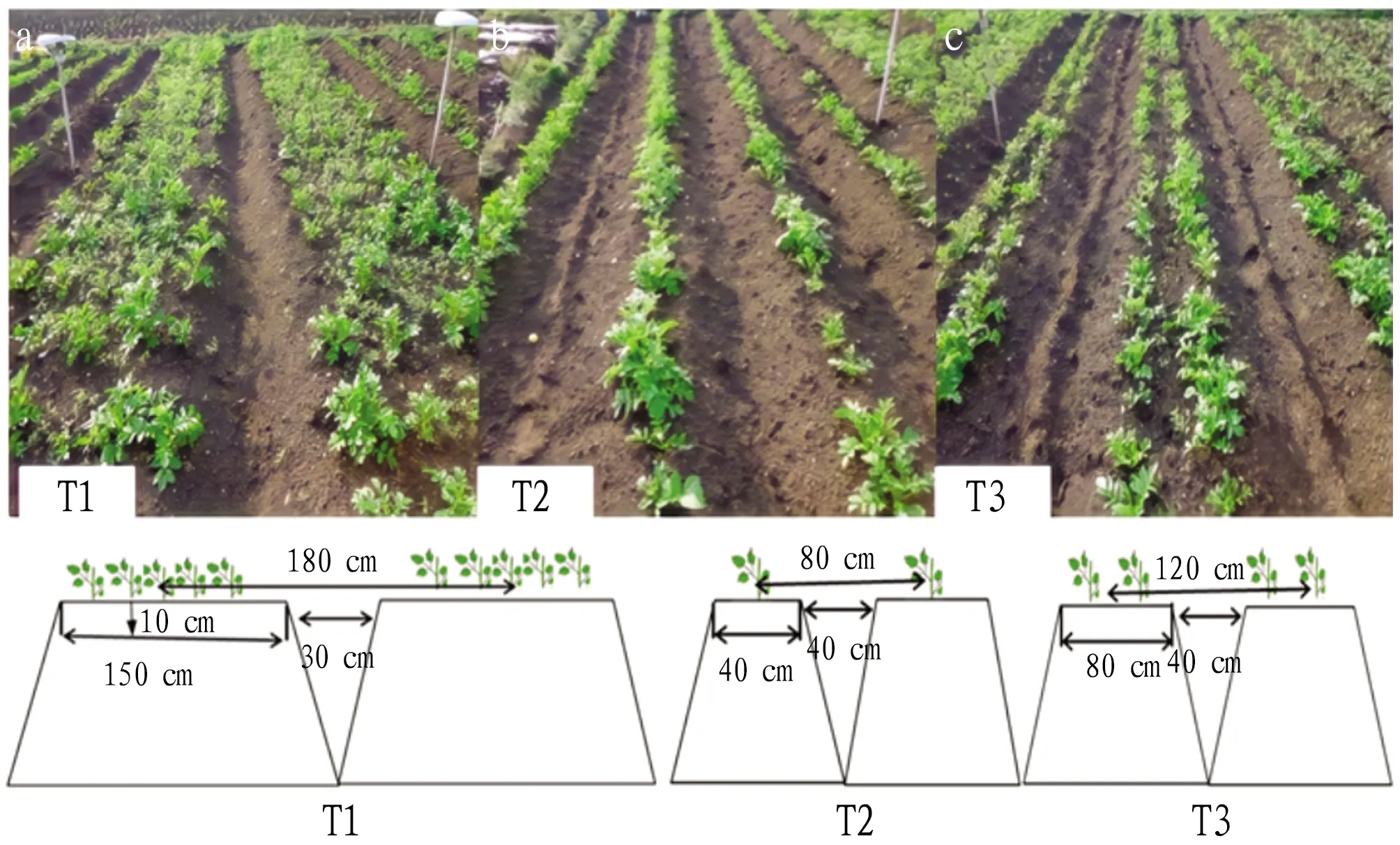
Note:(a)traditional cultivation T1;(b)single ridge-single row T2;(c)single ridge-double row T3.

Table 2 Treatment plot of potato in different planting density
2.2 Surveyed indicators
2.2.1Investigation of potato seedling rate.After the second soil covering, all potato seedlings in 9 plots were investigated, the number of seedlings emerged in each plot was recorded and the seedling growth rate was calculated.
2.2.2Investigation of potato agronomic characters.Five-point sampling method was used to record various agronomic characters of the potato plants at the flowering stage, two plants from each point were randomly selected, and the number of main stems, branches, and the leaf size index , underground stem length, plant height, stem thickness, root-shoot ratio and root level were recorded.The number of side emerged branches and leaf buds grown up to 10 cm or more were considered.
The size of randomly selected leaves was measured using the following formula:
Leaf area(cm2)=Dry weight of all leaves to be measured(W)×Sample leaf area(a)
Dry weight was obtained after exposing fresh leaves at 105 ℃ for 30 min to remove water content and dried at 80 ℃ in 48 h for constant weight.Plant height was measured from soil level to the aerial highest growing point; Stem thickness was measured using the first and second branches from the ground whereas root to shoot ratio: the ratio of the fresh weight or dry weight of the underground part to the aerial part size were reflecting the correlation between the underground and the aerial part of the plant.
2.2.3Soil temperature and humidity survey.The soil temperature and humidity of all plots were monitored during the flowering period(March 10)and the rapid expansion period of potato(March 26).The HOBO MX2304 weatherproof data logger was used as temperature and relative humidity sensor for 24 h monitoring.
2.3 Potato production recording
2.3.1Yield per plant.During the harvesting period, the five-point survey method was adopted in each plot, 2 plants were randomly selected from every point to record the weight per plant.The number of knotted and commercial potatoes was weighted.Normal potato pieces with a weight of more than 250 g, no mechanical damage, no deformity, and no disease were considered commercial; deformed, greener, diseased and pieces weighting less than 250 g were considered non-commercial.
2.3.2Yield per plot.Three points were randomly selected in each plot, every point was 3 m in size, commercial and non-commercial potatoes were weighted.
2.3.3Statistical analysis.The experimental data were analyzed with SPSS 18.0.
3 Results
3.1 Effects of planting density on plant growth and yield
3.1.1Effects of planting density on yield per plant.The yield by a single plant after harvesting period shows that there was a significant difference in the specific potato planting densities.Proportion was calculated by the weight of commercial potatoes to the weight of a single potato plant harvest.T3 commercial potato plant accounts the lower proportion of weight and showed a higher number of potato pieces of different sizes whereas T1 has showed a higher proportion of high weighed pieces(Table 3).

Table 3 Potato yield in the harvest per plant
3.1.2Effects of planting densityon yield per plot(60 m2).The results of the yield per plot showed that the weight of commercial potatoes, the weight of non-commercial potatoes, the weight of green-headed potatoes, the yield per plot and the commodity rate of the total yield between different processing areas were not significantly different.However, from the point of view of the equivalent per ha, the yield of T1 at high-density planting is higher than that of two other treatments(T2 & T3)nearly 7 500 kg, which has a greater impact on the total yield production(Table 4).

Table 4 Yield in the harvest yield per plot(60 m2)
3.2 Effects of different soil covering methods on potato
3.2.1Effects of different soil covering methods on potato roots.Through potted experiments, it was found that different soil covering depths had a greater impact on the growth of potato roots, and the root system level increased with soil covering compared to plants that were not covered.The potted experiments found that the root freshness in repeated soil cover was higher than that of the uncovered soil treatment, and the root freshness weight of the three-time covered soil was significantly higher than that of the control and other treatments(Fig.3).
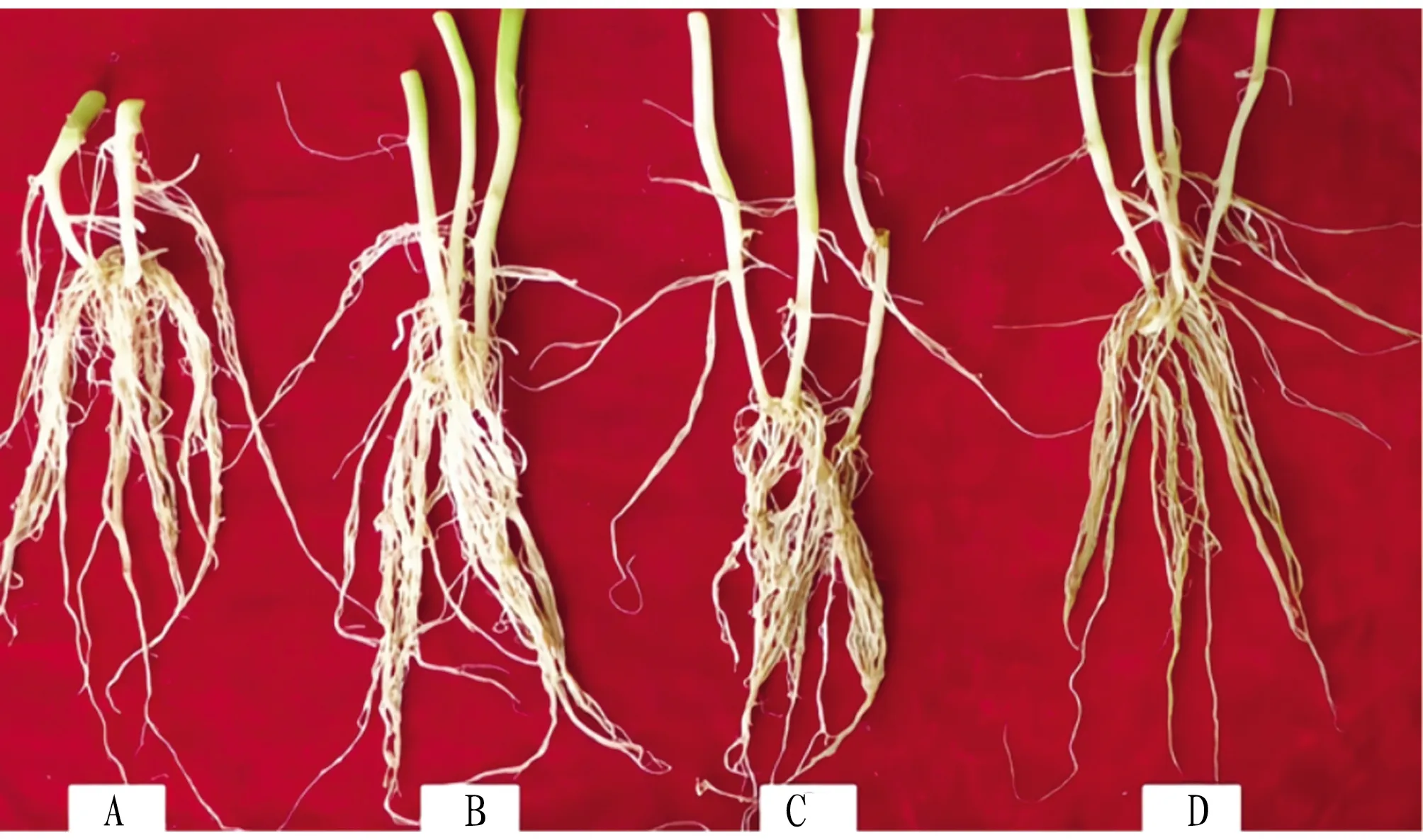
Note:(A)control without soil cover;(B)single soil cover;(C)twice soil cover;(D)three soil cover.
In addition, the length of underground stems was also greatly affected by the soil cover.The length of underground stems without cover treatment was only 9.2 cm, which is significantly lower than that of covered treatments(T2=18.6>T3=17.2>T1=15.5 cm).The two times soil cover treatment(T2)was significantly higher than the one cover, but the difference between the three treatments(T1, T2 and T3)was not significant(Table 5).
3.2.2Effects of different soil covering methods on yield in open field experiments.Field experiments results found that different soil covering methods had no significant effect on potato yield, but significantly affected the commercial nature of the plants productivity.The green head rate of potato treated with uncovered soil was significantly higher than that of covered soil.The difference between the other three soil covering treatments(T1, T2 and T3)was not significant, and the number of green heads potatoes was reduced in two times soil covering treatment(Table 6).

Table 5 Plant root growth of different covering soil

Table 6 Investigation of yield(60 m2)harvest in different covering soil treatments
3.3 Effects of different planting methods on plant growthWe investigated the growth of plants in three planting methods in Shiping County.The seedling stage survey and analysis found that the difference in seedling rates between the three treatments was not significant(Table 7).The various growth traits of potatoes were investigated during the budding period.From the data analysis in(Table 5), it can be seen that the root level, underground stem length and leaf area of the plants differed significantly from different planting methods.The treatment of T2 at the root level was significantly higher than that of T1 and T3.The difference between T3 and T1 was not significant, but numerically, the root level of T3 was higher than that of T1(Table 7).There is a significant difference in the length of underground stems between the three planting methods.The length of underground stems of T2 was 15.00 cm, which is significantly higher than that of T1 and T3(T2=15.00>T3=11.83>T1= 8.92 cm).
For the leaf area index, the analysis of the results shows that the leaf area index of a T3 is 199.7, which is significantly higher than that of T2(156.67)and T1(153.58), respectively.This predicts that the T3 planting density would be suitable to maximize the photosynthetic capacity of the plant which is proportionally linked to the stem and underground roots development(Table 7).However, other indicators of plants involved in the three cultivation methods, such as seedling developmental rate, number of main stems, number of branches, plant height and stem thickness, didn’t present a significant difference(Table 7).
3.4 Effects of different planting methods on yieldThe experiment measured the yield of three different planting methods.Through the analysis of variance, it can be seen that the constituent factors of the yield of a single plant between different treatments have not significant differences in the weight of potatoes, the number of tubers, the weight of commercial potatoes, and the quantity of commercial potatoes, but from the numerical analysis, it can be seen that the yield of T3 treatment is higher than that of the other two treatments(Table 8).Through plot production measurements, it was found that the commodity rate difference between different treatments was not significant, but the green head rate was significantly different.The green head rate of small-scale planting was significantly higher than that of large-scale planting, and the green head rate of a single ridge and a single row was also significantly higher than that of a single ridge and two rows.It can be seen from the analysis of regional production and the actual production in the region that the difference in output between different treatments is not significant.Comprehensive analysis of the single-ridge and double-row cultivation model has certain application value.
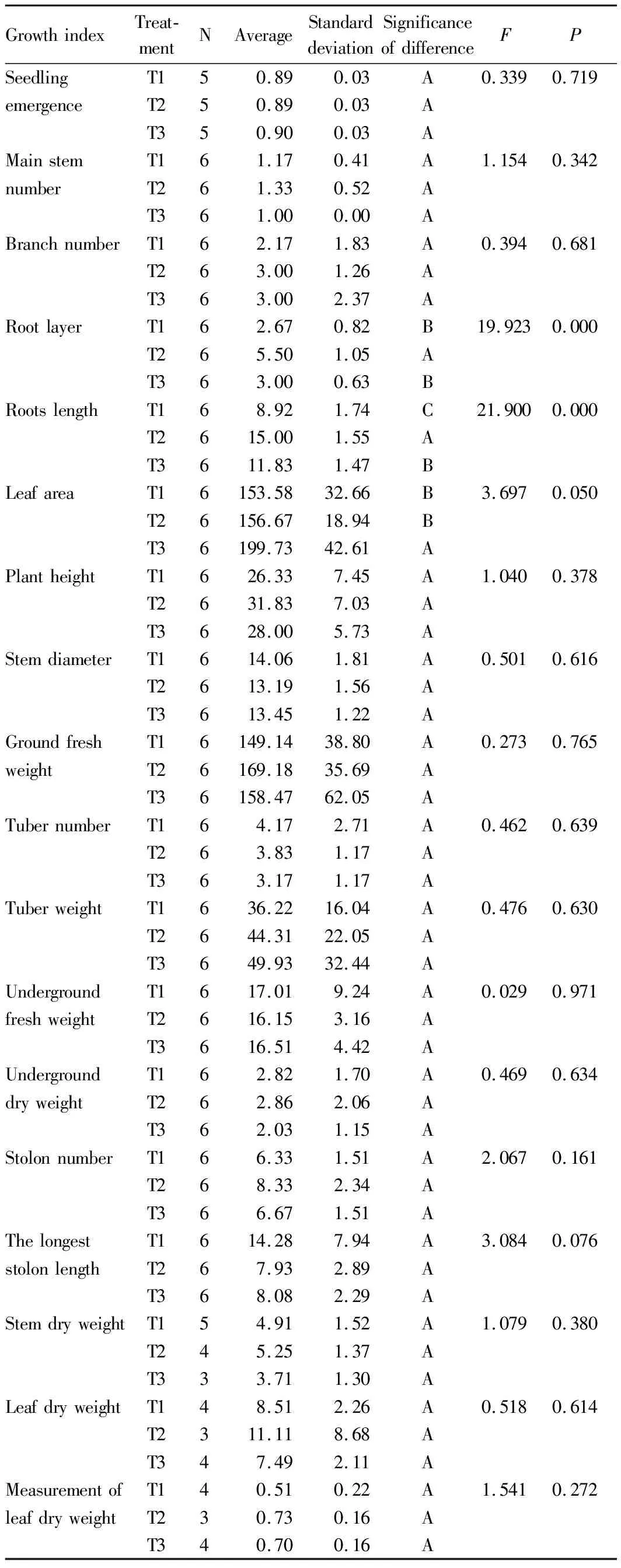
Table 7 ANOVA of potato growth in different cultivation models
3.5 Effects of different planting methods on soil temperature and humidityWe made record of the soil temperature and moisture content of different treatments during potato plant blooming period to evaluate the impacts of different cultivation models on the soil temperature and humidity.
3.5.1Effects of different planting methods on soil temperature.The results showed that the dynamic changes in the soil temperatures of the three treatments were consistent.The temperature has exponentially rise-up from 7:00 am to around 15:00, and gradually decreased after reaching the highest value.T2 showed the higher temperature compared to T1 and T3 treatments(T2>T1>T3)(Fig.4).There was not significance difference in temperature change between T1 and T2 treatments in the morning, but in afternoon, the temperature of T1 rises quickly and falls slowly.This predicts that T2 treatment may relatively be affected by the environmental conditions rather than T1 which can maintain soil temperature.However, T3 treatment with lowest temperature could have a strong buffering ability to cope with temperature stability.

Fig.4 Dynamic change of soil temperature
3.5.2Effects of different planting methods on soil humidity.Potato plantations are quite sensitive to moisture stress, so they need relatively high soil moisture levels to achieve high yields and quality production.The results from 24-h monitoring of soil moisture content in different treatments shows that, there is no defined variation within three treatments(Fig.5).The average shows that there is no significant difference in T1 and T3 compared to T3 treatments(T1=57%>T3=53%>T2=44%).In ridges-rows cultivation method, the water loss of T2 would be faster, and leads to lower moisturizing effect than in T1 and T3 treatments.
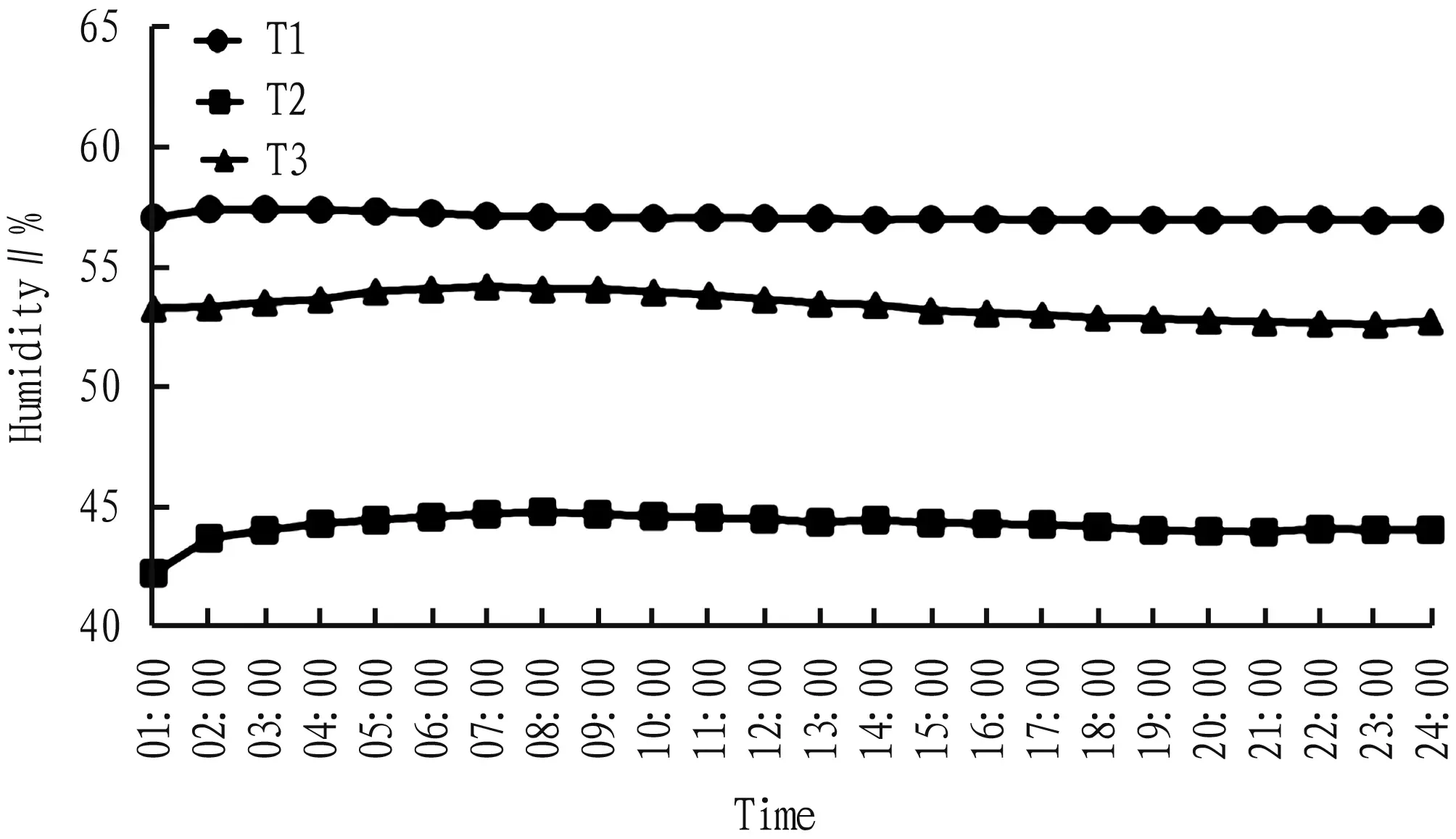
Fig.5 Dynamic change of soil humidity
From the analysis during the day and at night, it was found that the temperature difference between the three treatments during the day was not different but significantly different at night(T1>T2>T3)(Table 9); the change in soil moisture content shows that both T1 and T3 were significantly higher than T2(Table 9); the temperature difference between the three treatments during the day was not different but significantly different at night(T1>T2>T3)(Table 9); the change in soil moisture content shows that both T1 and T3 were significantly higher than T2(Table 9).

Table 8 Potato yield production from different cultivation models
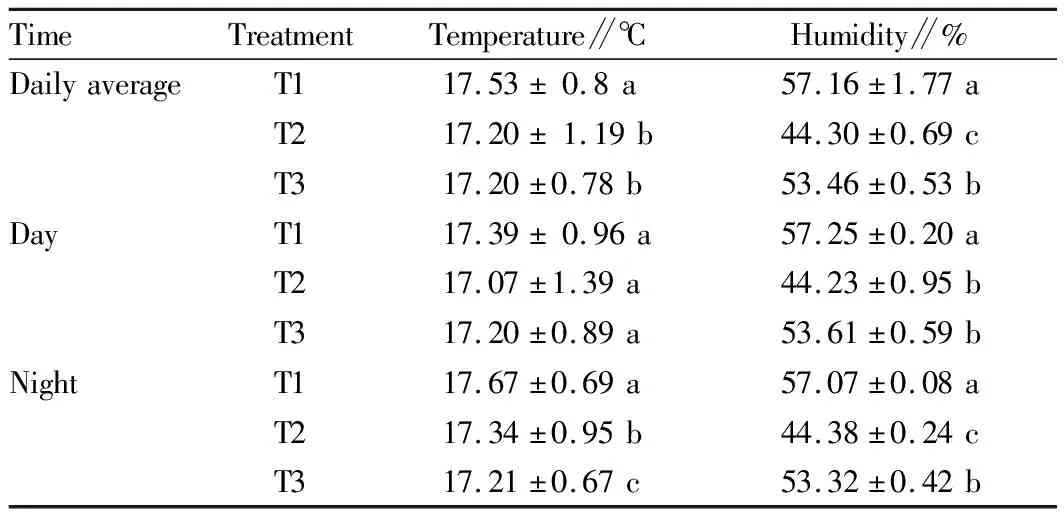
Table 9 ANOVA of soil temperature and humidity in different cultivation pattern
4 Discussion
4.1 Cultivation and planting modelsThe ridges-double-row cultivation model of has showed the significant different in potato commercial products compared to traditional and ridge-single row cultivation method.In agriculture system, the most important is time saving, resources management and yield projection.Ridges-rows cultivation model has been introduced and showed irrigation facilitation, fertilizers and related resources as well as land management in potato production system[14].This method can also improve the microclimate of the field to soil moisturizing effect[20]and can increase potato quality and quantity production[9].In this study, the ridges-double-row cultivation technique has positively impacted the length of underground stems, the root level, leaf area(Table 7), and significant commercial yield(Table 8).This model could effectively promote the increase of potato production, optimize labor productivity[16], and reduce economic losses and operating costs by improving the economic benefits of farmers[21].
4.2 Planting densityIn planting and production, reasonable regulation of potato planting density is an important way to ensure the high yield and quality in the field[16, 19].Presently, traditional and ridges-single-row planting models are widely used across China and in the different parts of the world at seedlings rate of 45 000-60 000 per ha[22].It is clear that the low density planting system can increase the field canopy ventilation, light transmission(Fig.4), and drainage facilities[11-12, 23].Winter season in Yunnan Province has low temperature and less rainfall, both conditions, reduce the occurrence and prevalence of late blight.Therefore, taking advantage of its winter climate and meteorological conditions and appropriately adopt high density planting approach at the rate of 83 370 seedlings per ha would effectively increase the yearly potato yields production(Table 7-8).
4.3 MulchingThe effect of different of soil covers on potato growth plays a big role in potato yield production[24, 28-29].The soil cover thickness may explain the increase in soil moisture content(Fig.5)which has greater effect on roots extension[13]and also has positive impact on potato tubers development.Mulching with about 15 cm soil covering depth(Fig.3B, C)has significant stem and roots development with reduction of the green-headed potato rate and increasing of commercial yield(Table 6)as reported that potato tubers value increases with soil cover thickness[18, 25-27].
5 Popularization and application prospects of efficient winter potato cultivation model
The planting model(single ridge-double row, secondary soil covering, and high-density planting)has been demonstrated and promoted in some areas of Yunnan Province(Fig.6).Among them, the highest output in Jianshui County, Honghe Prefecture has reached to the average of 84 t/ha whereas in Shiping County and Shuangjiang County the yield exceeds 60 t/ha.The average yield in other pilot areas can exceed 45 t/ha and the cumulative promotion area has exceeded 666.67 ha since 2013.At present, Yunnan Province winter potato yield production is ranked the first in the China, and planting area has reached 166 000 ha in 2021.
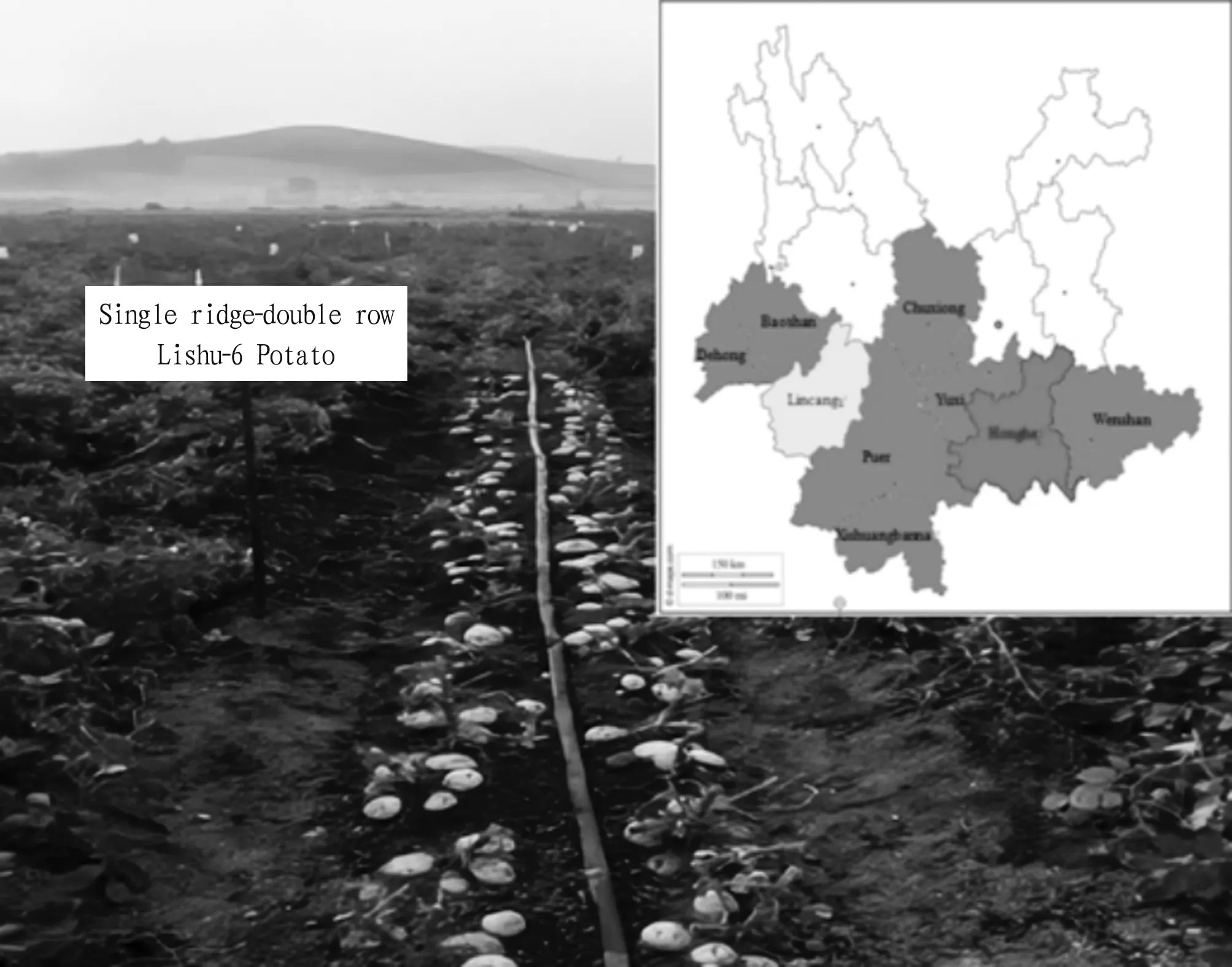
Fig.6 Planting model(single ridge-double row, secondary soil covering, and high-density planting)extension zones
6 Conclusions
To maximize potato yield, it is necessary to adopt the dominant cultivation model.Our study showed that ridge-double row, high density at the rate of 83 370 seedlings per ha, and twice soil covering about 10 cm depth can increase the potato productivity average from 18 t/ha of the current used cultivation model to 45 t/ha.Therefore, the combination of this method with modern agriculture mechanization should be further popularized and applied in large scale planting in regions with climatic conditions similar winter season in Yunnan Province.This could effectively facilitate potato cultivation, and reduce the standard planting costs and increase potato production industry at the large scale, to satisfy the world potato need and support the Sustainable Development Goals(SDGs)(1, 2 and 12)of the United Nations.
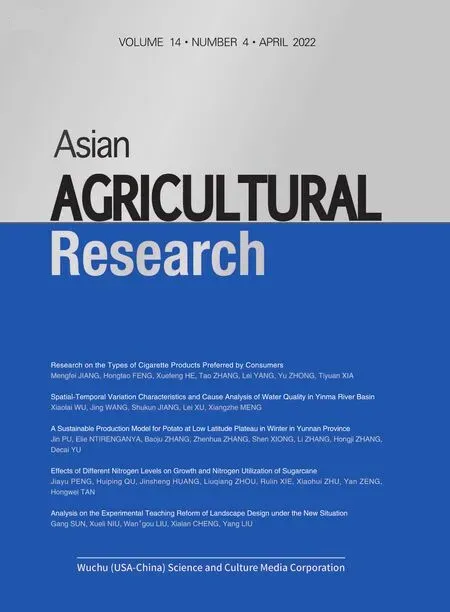 Asian Agricultural Research2022年4期
Asian Agricultural Research2022年4期
- Asian Agricultural Research的其它文章
- Occurrence and Damage and Pathogene of Potato Early Blight in Winter in Yunnan Province, China
- Chromatograph Skeleton Components of Feng-flavor Baijiu during Different Production Stages
- Analysis and Strategy Research on the Mathematics Learning Situation of the Postgraduate Candidates
- Application of ETA in the Management of Mental Health Education for College Students
- Research on the Types of Cigarette Products Preferred by Consumers
- Current Situation of E-commerce Entering Rural Areas in Datong County of Qinghai Province
